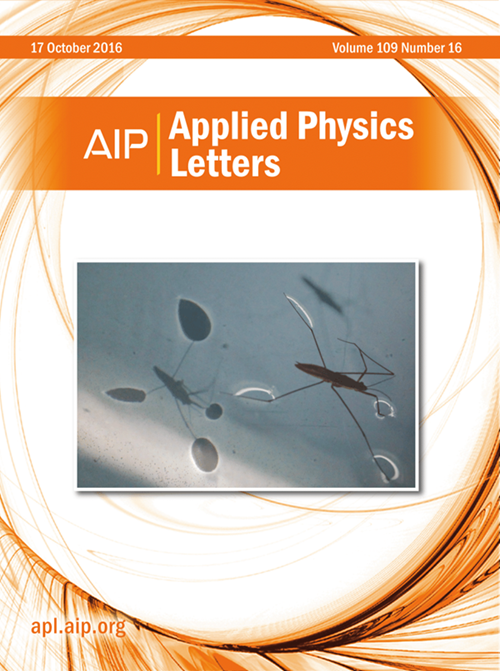Dielectric breakdown of atmospheric-pressure grown hexagonal boron nitride single crystals
IF 3.5
2区 物理与天体物理
Q2 PHYSICS, APPLIED
引用次数: 0
Abstract
High-quality hexagonal boron nitride (hBN) has emerged as a reliable dielectric material for two-dimensional (2D) electronic devices because of its atomic flatness, ultrahigh optical transparency, wide energy bandgap, and high dielectric breakdown field. Traditionally, the best-quality hBN is mostly synthesized under high pressure and high temperature (HPHT). Because the HPHT method requires complex apparatus and limits the size of hBN crystals, it is desirable to grow large-area and high-quality hBN single crystals by a simpler method such as the synthesis under atmospheric pressure and high temperature (APHT). However, the comprehensive characterizations of APHT grown single crystals, particularly the dielectric breakdown information required for electronic applications, are still lacking. Here, we fabricate more than 30 graphite/hBN/graphite devices to systematically characterize the dielectric breakdown behaviors of APHT grown hBN crystals, along with other hBN crystals grown by different methods or vendors for direct comparison. The field values of dielectric breakdown, defined by the onset of leakage current, monotonically increase with the decrease in hBN thickness. Below the thickness of 10 nm, the field value reaches above 8 MV/cm. The dielectric breakdown behavior is comparable to that grown by HPHT. Our statistic results, along with the characterizations of X-ray diffraction, Raman spectroscopy, atomic force microscopy, and optical second harmonic generation microscopy, show that the hBN crystal under APHT is an ideal substitute for designing and fabricating the best-quality 2D electronic devices.常压生长六方氮化硼单晶的介电击穿
高质量的六方氮化硼(hBN)由于其原子平整度、超高的光学透明度、宽能带隙和高介电击穿场而成为二维电子器件可靠的介电材料。传统上,高质量的hBN大多是在高压高温条件下合成的。由于HPHT方法需要复杂的设备,并且限制了hBN晶体的尺寸,因此希望通过更简单的方法如常压高温合成(APHT)来生长大面积和高质量的hBN单晶。然而,对apt生长单晶的全面表征,特别是电子应用所需的介电击穿信息,仍然缺乏。在这里,我们制作了30多个石墨/hBN/石墨器件,系统地表征了APHT生长的hBN晶体的介电击穿行为,并与其他不同方法或供应商生长的hBN晶体进行了直接比较。随着hBN厚度的减小,介质击穿场值单调增加。厚度在10 nm以下,电场值达到8 MV/cm以上。其介电击穿性能与高温高压生长的介电击穿性能相当。我们的统计结果,以及x射线衍射、拉曼光谱、原子力显微镜和光学二次谐波产生显微镜的表征表明,在APHT下hBN晶体是设计和制造高质量二维电子器件的理想替代品。
本文章由计算机程序翻译,如有差异,请以英文原文为准。
求助全文
约1分钟内获得全文
求助全文
来源期刊

Applied Physics Letters
物理-物理:应用
CiteScore
6.40
自引率
10.00%
发文量
1821
审稿时长
1.6 months
期刊介绍:
Applied Physics Letters (APL) features concise, up-to-date reports on significant new findings in applied physics. Emphasizing rapid dissemination of key data and new physical insights, APL offers prompt publication of new experimental and theoretical papers reporting applications of physics phenomena to all branches of science, engineering, and modern technology.
In addition to regular articles, the journal also publishes invited Fast Track, Perspectives, and in-depth Editorials which report on cutting-edge areas in applied physics.
APL Perspectives are forward-looking invited letters which highlight recent developments or discoveries. Emphasis is placed on very recent developments, potentially disruptive technologies, open questions and possible solutions. They also include a mini-roadmap detailing where the community should direct efforts in order for the phenomena to be viable for application and the challenges associated with meeting that performance threshold. Perspectives are characterized by personal viewpoints and opinions of recognized experts in the field.
Fast Track articles are invited original research articles that report results that are particularly novel and important or provide a significant advancement in an emerging field. Because of the urgency and scientific importance of the work, the peer review process is accelerated. If, during the review process, it becomes apparent that the paper does not meet the Fast Track criterion, it is returned to a normal track.
 求助内容:
求助内容: 应助结果提醒方式:
应助结果提醒方式:


